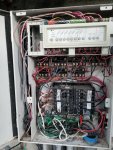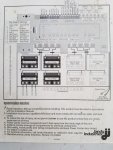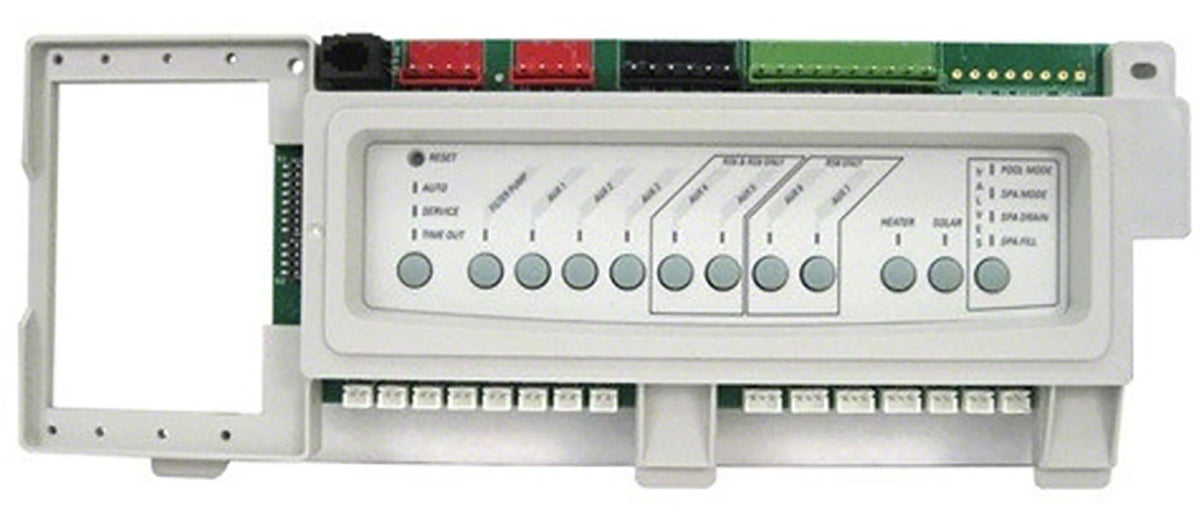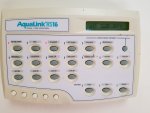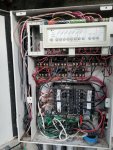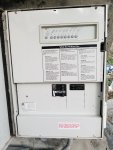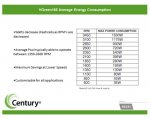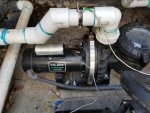I have a 20,000 gallon inground pool with a large rooftop solar run by a Jandy Aqualink RS16 system and am investigating upgrading my pool pump from single speed to variable speed. But my understanding is lowering the flow rate by lowering the speed to save power also reduces the solar efficiency since solar desires a high flow rate and only operates when their is adequate heat. My existing single speed 1.5 HP pump filters the pool and when the solar is enabled by Jandy Aqualink timing cycle AND there is sufficient heat difference between the panels and water, a diverter runs the post filtered water up into the rooftop solar and back to the pool return.
It appears the Jandy controller has a control pair for "solar pump" that is not used. I'm curious if I add an additional solar booster pump along with a new relay controlled by the "solar pump" 24VAC control pair, will it properly run the new solar booster pump when solar is on and the temperature is sufficient. This should be roughly the same as the solar diverter control signal. I would change the plumbing so the new solar booster pump draws pre- main filter pump water with a one way check ( for no backflow from rooftop) valve and returns into the pool outlet pipe also with a backflow check valve so it can't fight the pool pump.
The normal pool filter flow then could be a variable speed variable flow pump optimized for pool turnaround and minimum power running at night when power is cheap while the solar booster would run as efficiency as I can arrange it ( based on pump curves), during sunny days when there is adequate heat in the panels.
Does anyone know if this makes sense in solving the contradiction between pool filtering which can run when power is cheapest and at a slow turnaround to minimize power consumption? But the solar pump wants maximum flow and maximum efficiency and must run when the sun is out and heat is available between about 9-10AM and 3-4PM ( or so) but this varies from early spring to fall.
How else can the contradiction be dealt with? The booster could tap filtered water so it increases turnover and reduces the time the variable speed pump would operate. Any ideas on how these two problems is dealt with? Does anyone know how the Jandy Aqualink RS16 control board "solar pump" signal is times relative to the diverter timing I currently have where the main pump does both filtering and solar?
thanks
It appears the Jandy controller has a control pair for "solar pump" that is not used. I'm curious if I add an additional solar booster pump along with a new relay controlled by the "solar pump" 24VAC control pair, will it properly run the new solar booster pump when solar is on and the temperature is sufficient. This should be roughly the same as the solar diverter control signal. I would change the plumbing so the new solar booster pump draws pre- main filter pump water with a one way check ( for no backflow from rooftop) valve and returns into the pool outlet pipe also with a backflow check valve so it can't fight the pool pump.
The normal pool filter flow then could be a variable speed variable flow pump optimized for pool turnaround and minimum power running at night when power is cheap while the solar booster would run as efficiency as I can arrange it ( based on pump curves), during sunny days when there is adequate heat in the panels.
Does anyone know if this makes sense in solving the contradiction between pool filtering which can run when power is cheapest and at a slow turnaround to minimize power consumption? But the solar pump wants maximum flow and maximum efficiency and must run when the sun is out and heat is available between about 9-10AM and 3-4PM ( or so) but this varies from early spring to fall.
How else can the contradiction be dealt with? The booster could tap filtered water so it increases turnover and reduces the time the variable speed pump would operate. Any ideas on how these two problems is dealt with? Does anyone know how the Jandy Aqualink RS16 control board "solar pump" signal is times relative to the diverter timing I currently have where the main pump does both filtering and solar?
thanks



